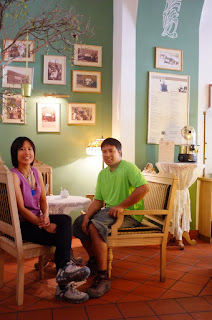- Churches in Cracovia. It has been said that there are hundreds of different churches in Cracovia and not just famed for their architectural and historical value: they conceal extraordinary memorials of historical figures. Aside from the previously mentioned Corpus Christi church with the boat-like structure of the pulpit, and the St. Mary's church, here are some others we saw:
 |
| Front St. Barbara's Church |
(Source of information: Krakow Travel). I specially admire the luminosity and the immaculate atmosphere of this church and the figure of the peata.
Source of Peata Image : Wikipedia by Ludwig Schneider/Wikimedia/Commons
Source of Peata Image : Wikipedia by Ludwig Schneider/Wikimedia/Commons
 |
| St. Barbara's Church |
| Peata |
St. Francis of Assisi Church: Check the link because this is probably the most beautiful church in Cracovia. This was recommended to us by our train compartment companion on the way to Krakow. Indeed something not to be missed. This is a piece of art beatified (?). The Franciscan Church was founded in the first half of the 13th. century and it was one of the first brick constructions in Krakow. (Source of information: Krakow 4U.pl) They have some magnificent stained glass windows that illuminate like rays from heaven. This church really inspires you to kneel down and pray.
The Holy Trinity Church - The great prestige enjoyed by the order of St Dominic made the church of the Holy Trinity into one of the grandest in Krakow. Both the church itself, and the monastery cloisters filled with countless number of tombs, and the set of burial chapels of the 16th and 17th centuries was second only to the Wawel Cathedral necropolis. The interior of the church gives an impression of emptiness and coldness. The opulence and formal variety of original altars disappeared with the 1850 fire and was replaced by a uniform neo-Gothic decoration. Source of Info:Krakow 4u.pl
We had a short walk around the Wawel Castle to see part of the lake and the surroundings and saw the legendary dragon, souvenir shop and the stars's walk.
Then it was time to go to our scheduled tour of the famous Wieliczka Salt Mines. In the meantime we sat in front of a restaurant near the tour bus stop and while we were waiting with a cone of ice cream to pass the time, we had the opportunity to listen to some Polish music just in front where Mel and me were seated on a bench.
The salt mines are a thirty minute bus ride from the city centre and a well trodden part of the tourist trail. They are unquestionably a marvel, and they have been under the aegis of UNESCO since 1978. This deposit of rock salt in Wieliczka-Bochnia has been mined since the 13th century. Spread over nine levels, it has 300 km of galleries with works of art, altars, and statues sculpted in the salt, making a fascinating pilgrimage into the past of a major industrial undertaking.
Not only was the Wieliczka salt mine a valuable economic raw material, it also inspired the creation of exceptional works of art, such as chapels with altars and figures made of this atypical material.
Wieliczka attract visitors because of its uniqueness and beauty almost from the beginning of its existence. The first tourist route was opened in the middle of the 19th century.
Our experience will have to wait to be related in Part IV of our travel to Cracovia.














All churches in Krakow are astonishing! In Jewish Town we saw as well the Corpus Christi church and was a great discover!
ReplyDeleteThe bakery shop in Krakow was Ciasteczka z Krakowa